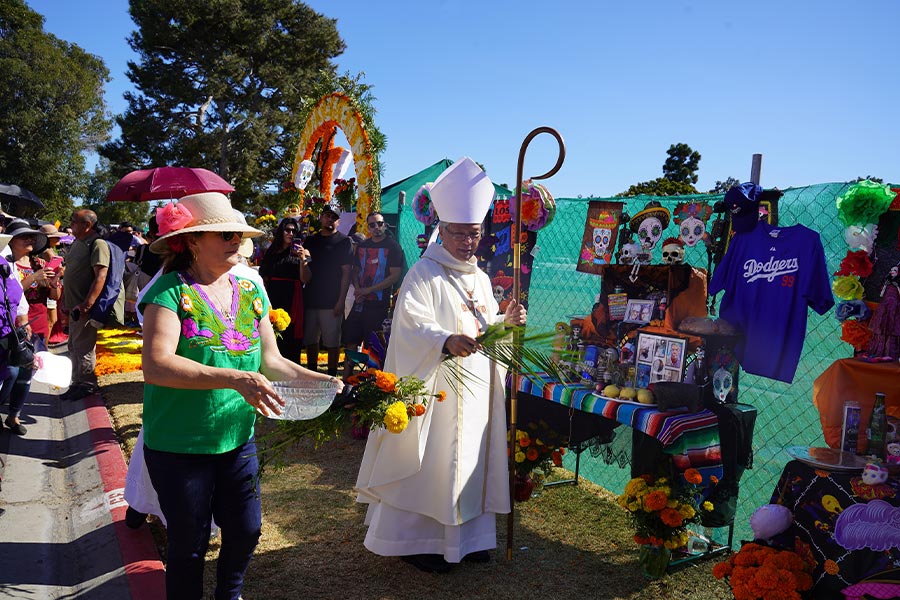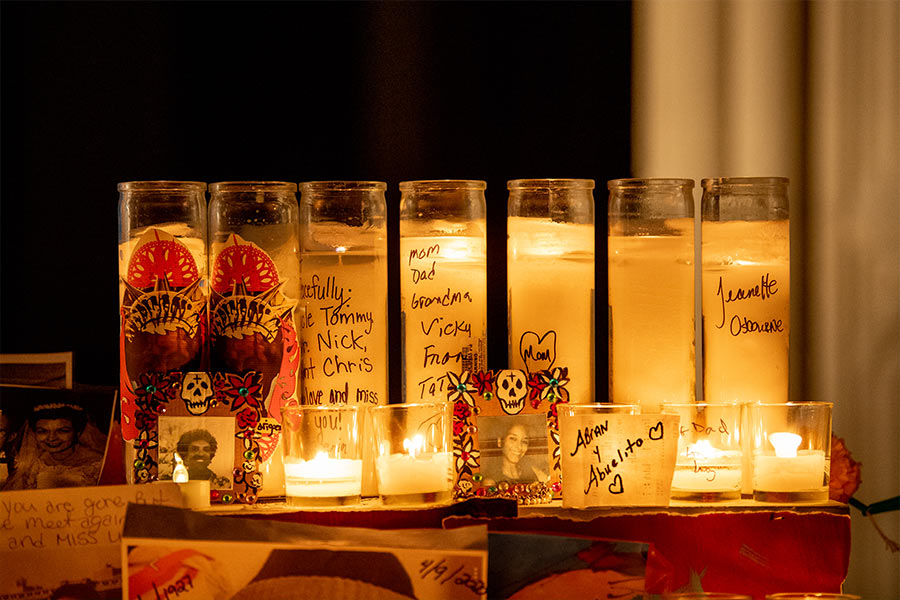The Day of the Dead: An ancient custom fused with Catholic traditions

Photos of deceased parishioners are displayed on altares or ofrendas as a way to remember to pray for them during the month of November. The altares were set up in the parish hall of Our Lady of Guadalupe Parish in Wichita Falls. (NTC/Juan Guajardo)
DENTON — As in years past, Ana Magallanes, 40, a parishioner of Immaculate Conception Parish in Denton, on November 2 will arrange together with her two daughters, a private home altar for the Day of the Dead with ‘ofrendas’ (offerings) for their loved ones who have passed away.
“At home we prepare the altar with photos of our parents, a nephew, and a brother,” explains Magallanes, originally from Guanajuato, Mexico, who came to Denton with her parents 26 years ago. In addition, families also visit cemeteries and bring food and drink offerings that the deceased would have enjoyed while they were alive.
The Day of the Dead tradition gives her the opportunity “as a Catholic, to remember my loved ones and pray for them,” but it also enables her to teach “our daughters about their relatives who are already in heaven.”
She emphasized that, as an immigrant, it is important “not to forget our culture. When I got to this country, I learned about Halloween, but I also wanted my daughters to know my traditions well. I never met my grandparents in person. However, it was through the photos that we put on the altar at home, and the anecdotes that my mother told me, that I got to know them. Just the same way I do it with my daughters now,” she added.
She recalled her childhood in Mexico, when she and her mother decorated their makeshift altar with colorful paper figures, flowers, candies in the shape of a skull, candles, and of course, photographs of her grandparents.
In addition to the altar at home, for the last three years, Magallanes has been helping to arrange the altar for the Day of the Dead at her daughters’ school, Immaculate Conception Catholic School, as a member of the Mamás Latinas group.
“We want young people to know our Latino culture and how important the altar of the Day of the Dead is for us because this is how we remember our loved ones who are no longer with us,” she said.

Although it will not be possible because of the pandemic this year, Magellan hopes to continue next year with the ofrenda at the school, and distributing sweet bread to the children, while explaining the meaning of the traditions of the Day of the Dead.
“We are very grateful to the school principal, Elaine Schad, who gave us the opportunity to form this group and allow us each year to set up this altar at the entrance of the school to share this beautiful part of our faith and our culture with the students and the school community," she said.
All Saints Day and All Souls Day, separate feast days of the Catholic Church, are united — particularly among Latinos — with the Day of the Dead, a cultural tradition that is important to preserve and understand in depth, noted Sister Araceli Lobatón, Director of Religious Education at Immaculate Heart of Mary Parish in Fort Worth.
The celebration of the Day of the Dead “is not a ceremony of horror and fear, but rather the celebration of an encounter,” explained the religious Missionary Catechist of the Sacred Hearts of Jesus and Mary.
Sister Araceli pointed out that in the pre-Hispanic world there was a belief that when people died they did not perish forever, but instead went to Chicunamictlán, the land of the dead. However, to reach that place where they were going to rest, they had to travel a long way, so they buried the dead with their belongings and food for that journey. Hence, the tradition of placing on the altars of the Day of the Dead the dishes that deceased loved ones liked and items that they used.
“It was believed that there were three levels in the Land of the Dead, one for warriors who had died in battle, a second level for children, and another for ordinary people,” Sister Araceli said.
“Every year, they held a ritual during which they spiritually connected with the dead. After the Spanish Conquest and the arrival of the Franciscan and Augustinian missionaries, who brought the Good News of the Gospel to the New World, this ancient tradition was purified, not taken away, but mixed with the Christian traditions of All Saints’ Day and the Day of All Souls on November 1 and November 2, respectively,” explained Sister Araceli, originally from Tlaxcala, Mexico.

Los Angeles Auxiliary Bishop Alejandro D. Aclan blesses items with holy water during the Dia de los Muertos (Day of the Dead) celebration at Santa Clara Cemetery Oct. 26, 2019, in Oxnard, Calif. Day of the Dead is a Mexican custom traditionally observed Nov. 1 and 2 to remember family and friends who have died. (CNS photo/Sarah Yaklic, courtesy Archdiocese Los Angeles)
“Through our Christian faith, we believe that our soul does not die, but lives forever and goes to meet our Creator,” she said, pointing out that the tradition of the Day of the Dead is part of many Latin Americans’ identity. “It is very important to communicate the correct information about this tradition because, otherwise, there is a risk is that it could be seen as something that is not good, when in fact it is a tradition with pre-Hispanic roots, permeated with the Gospel.”
Sister Araceli explained that the purpose of this tradition is “to pray as a family in communion with loved ones who have already left this world to meet with the Lord.
“We unite with them not physically, but spiritually in prayer,” said Sister Araceli, highlighting the importance of forming children, and their parents, on this tradition that is particularly rooted in Central and Southern Mexico.
AT HOME AS IN THE CHURCH
Having an altar at home for the Day of the Dead is not a bad thing, explained Father Alejandro López, CORC, parochial vicar of Immaculate Heart of Mary Parish, as long as one has “the awareness that prayer is done for the soul of the deceased.”
From a Christian perspective, the important thing is that the offering (ofrenda) is “a remembrance of those who are no longer with us. That the families gather around the offering to pray the Rosary for the eternal rest of the deceased,” Fr. López explained.
“[Typically] candles are lit, as they represent the meaning of the Light of Christ that leads the soul of the deceased to God. Everything else is part of the folklore and tradition,” he added.
Fr. López stressed that when we celebrate All Souls’ Day on November 2, we must have “that awareness and belief that we really are soul and body; and that when we die we go to heaven, or to purgatory, or sadly, some to hell. We give our prayer, our offering, in commemoration of all the loved ones who have died, asking God to grant them eternal rest.”
Catholics also help hasten the purifying journey to heaven of the faithful departed by gratefully offering penance, works of mercy, and especially the holy sacrifice of the Mass.
On November 1, All Saints Day, “we remember those who are already saints, those who already enjoy heaven,” Fr. López said. “We give thanks for their sainthood, and we try to imitate that example.”
The priest went on to explain that we not only celebrate the saints that the Church has canonized, but also the “saints that we meet in our daily lives,” as Pope Francis pointed out in his encyclical Gaudete et exsultate. Those people we have met or that were our relatives, who because of their good deeds in life, their faith, and their suffering, can be considered saints even though the Church has not officially recognized them through the process of canonization to sainthood.

A detail view of "The Corona Altar," an installation by artist Scherezade García marking Dia de Los Muertos (Day of the Dead). The piece includes personal offerings placed by visitors to the Green-Wood Chapel at Green-Wood Cemetery in Brooklyn on October 30, 2020 in New York City. Many Halloween events have been canceled or adjusted with additional safety measures due to the ongoing coronavirus (COVID-19) pandemic. (Photo by Roy Rochlin/Getty Images)
“These days are important because the Church unites in a single prayer,” the priest added. He noted that we all unite in one prayer, as the church militant (which is us on earth), the church suffering (which are the souls waiting to arrive to heaven), and the church triumphant (which are those who are already in Heaven’s Glory).
On the solemnity of All Saints, in the prayers for our loved ones on All Souls, and with the altars and ofrendas on the Day of the Dead, the important thing, according to Father Alejandro López, is “to evangelize and give the real meaning to the traditions,” understanding that “death is that step towards true life, with the example of Christ, who conquered death.”
SYMBOLS OF DAY OF THE DEAD
Sister Araceli Lobatón, Director of Religious Education at Immaculate Heart of Mary Parish in Fort Worth, shed light on the Christian and folkloric significance of a few traditional elements Day of the Dead altars.
The cross: It is the cross of Jesus, which represents the ultimate destiny of our loved ones and our own with Jesus in heaven.
The candles: They symbolize the light of God, which guides the soul of the departed towards Him.
Water: It represents purification and quenching the thirst on the way to heaven.
The flowers (particularly, the marigold flower): Because of its striking sun-like radiance and rich fragrance it is a guide for the faithful departed, first, to the altar, and then back to heaven or to purgatory.
Incense: Represents our prayers raised to God.
Papel picado (delicate paper designs): Gives a cheerful sense of welcome, especially because of its bright colors.
Photographs: To remember and honor the lives of our loved ones.
Food: To remember and honor the memory of our loved ones with the food they liked.
The bread of the dead: It symbolizes our human body and the cycle of life.
